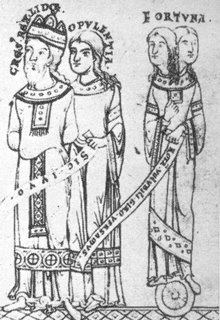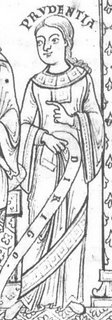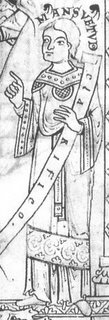I'm not even halfway yet :-)
The following entry (no 6 only) is also illustrated in Davenport's "Book of Costume"
6.Prüfening "Vices and Virtues" Prufening Miscellany CLM 13002 f3v&f4 1158/65 (Bayerisches Stadtsbibliothek, Munich)
- Prüfening was an (influential) abbey just outside Regensburg (then capital of) Bavaria.
- Wikipedia (slightly unreliable, but so tempting, and generally giving the info i wanted most sucinctly) gives slightly differing versions of the 7 virtues and vices, but I think I can guess at most of them.
- The complete illustration is apparently (Dodwell gives examples) full of paralells and symbolism.


filia Babylonis (daughter of Babylon) with Cupiditas (greed),paralleled by Daughter of Sion (filia Syon) with caritas (charity).


A King (Lido?) with opulentia (wealth/oppulence) accompanied by fortuna (fortune), opposed by prudentia (prudence/foresight).


honortay petentia? (?)opposed by Mansvetd?(or is it M Ansu Etudo?).


potentia (might) opposed by Longanimitas (forbearance).


Gula?, (gluttony) opposed by humilitas (humililty).


voluptas (pleasure) oppossed by sobriatas (sobriety/temperance).
I think I've still got some of those pairings wrong, but I'll work on it. And I'd welcome info on who the mystery pair is.

3 comments:
Are there any particular features that make you think male or female in these garments? Everyone is rather flat chested and their heads are uncovered, but the garments are long. There's a substantial amount of foot, but no leg... they seem almost androgynous. What are your thoughts on what makes these garments distinctly male or female?
Thanks!
I wrote a long answer and blogger ate it:-(
The short answer is there are fairly androgenous garments. A lot of the markers are in how you wear the garment (beard, phygian cap, cloak fastened over the right shoulder = male, veil, long plaits, 3rd layer = female).
There are two gender differences I've noted in the garment, but i doubt they are big enough to be distingctive. The female garments tend to tighten up under the bust and have pendant sleeves. The male garments are broader in the shoulders and nearly all have tight sleeves. At least in this manuscript.
But I wouldn't be the least surprised if these garments were androgenous.
(better pictures of the men: http://teffania.blogspot.com/2007/01/revisiting-prfening-miscellany.html)
As I read it, the "mystery pair" says:
HONORIS APPETENTIA [the immoderate desire for honor]
MANSUETUDO [meekness], which you already identified.
Also: GLA is not GULA, bit GLORIA (the L has a slash across it, which means that at that point there is an abbreviation; gla (with slash) is the customary abbreviation for GLORIA. The opposite is, of course, HUMILITAS.
Terrific blog, I am glad I discovered it, though a bit late!
Post a Comment